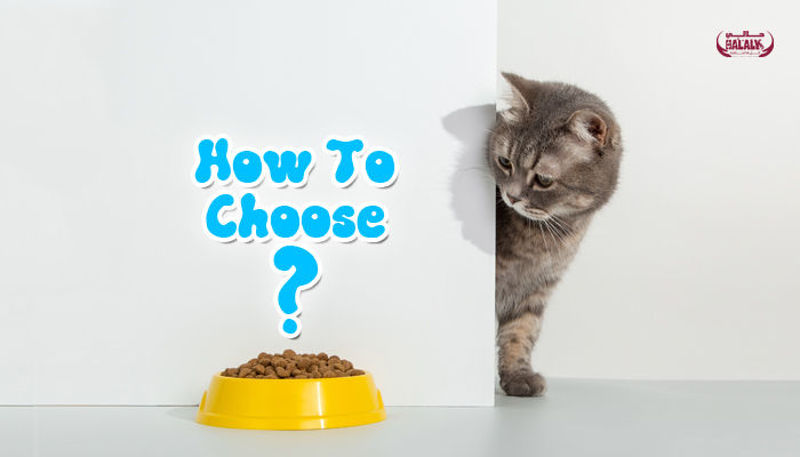The matter of choosing the ideal food for cats worries many cat owners. The cat owner usually thinks about the healthiness of the available options of dry food, wet food, or canned food. Many do not know what their cat’s nutritional needs are and how they can be met and avoid food that is harmful to cats.
In this blog, we provide you with important information about cat food. We will discuss the difference between types of food and how to choose from the best types of dry food for cats.
What Is The Difference Between Dry Cat Food And Wet Cat Food?
Dry food is characterized by the fact that it contains measured amounts of nutrients, carbohydrates, protein and salts, in addition to being easy to store and has a shelf life for a long period because it contains a small amount of water. Therefore, dry food is an ideal choice for cat owners.
However, it is recommended to provide cats that consume dry food with a large amount of water, to maintain the health of the kidneys and urinary system.
As for wet food, it contains a greater amount of water and protein, is softer and easier to chew, and is usually more expensive than dry food.
Features And Benefits Of Dry Food
Dry food has many features that make it superior to other types of cat food in some cases. Among the advantages of dry food is that:
-
Quick and easy food to prepare
-
Contains a precisely calculated amount of nutrients
-
Contains little moisture, so it does not spoil quickly
-
The favorite food for most cats
-
A relatively cheap food source than wet food
-
Does not need to be stored in the refrigerator
-
You can serve it to cats in different ways, such as serving it in regular dishes, maze-shaped dishes, or an automatic feeder. Your cat’s mealtime will turn into a time of fun.
How To Choose Among The Best Types Of Dry Food For Cats
The process of choosing the right food for cats takes a lot of time and many attempts and experiments to reach the ideal food for your cat. Not only is the matter limited to each cat's appetite and personal preferences, but it is also subject to other considerations, such as the nutrients the cat needs, the food appropriate for its age and health condition, or the ingredients that may cause it to have some side effects, in addition to the preferences of the cat itself. If you are thinking about important nutrition for your cat, you can read about the best types of cat food. In the following lines, Halaly gives you 5 tips for purchasing the best types of dry food for cats:
First: Learn about the basic nutritional elements that are important in cat food
When searching for the best cat food, whether it is canned food, wet food, or dry cat food, always make sure to look for products that contain the most important elements necessary to maintain cat health.
Note that the order in which food ingredients are written on the package indicates their percentage. The first mentioned ingredient is always the highest percentage of the food contents, the second is the least concentrated, and so on.
The most important elements that must be present in cat food are:
Protein:
Protein is the most important nutrient that cats need to build a healthy body. When searching for the best types of dry food for cats, choose the types that contain the largest percentage of protein. It is recommended that the percentage of protein in cat food not be less than 25% of the total package.
Always look for products that contain specific sources of protein, such as chicken, lamb, turkey, tuna, and salmon. You can buy products that contain chicken organ meat, such as liver and heart. They are rich sources of taurine amino acid.
Taurine is an essential amino acid in cat food. A lack of taurine causes major health problems for cats, such as heart disease and blindness.
Fats:
The second most important element in cat food is fat. Cat food must contain at least 20% fat in order to meet the cat’s physical needs. Many people think that low-fat food is more beneficial for cats, but this may cause disturbances in the eating behavior of cats, as they may resort to binge eating to compensate for the nutrients that they did not obtain from those foods.
Carbohydrates:
Cats are primarily carnivores, so carbohydrates are not so essential to a cat's diet.
However, most cat foods contain some carbohydrate as an additional factor that helps bind the main ingredients together.
It is necessary to pay attention to the type of carbohydrates the food contains, as some cats may suffer from digestive disorders as a result of an allergy to some ingredients, the most famous of which is corn grains. Therefore, we recommend using products that contain different types of carbohydrates, such as potatoes or green peas, if your cat is allergic to corn.
Second: Don't neglect your cat's own needs
Not all cat bodies have the same physical needs. Some cats may need certain nutrients in greater quantities than their counterparts. For example, the needs of a young kitten differ from the needs of a pregnant cat or the needs of older cats.
Health or medical conditions also affect nutritional needs. Some cats may suffer from a disease as a result of a deficiency in a particular nutrient, and therefore they must be provided with higher concentrations of it in order to compensate for this deficiency. Some cats may also suffer from allergies to some ingredients in the food, so you should avoid offering them these foods.
Don't forget to consult your vet about your cat's needs.
Third: Your cat's personal preferences. Experience is the best guide
Just like humans, cats each have a personal preference for certain types of foods. If you've recently adopted a cat, you may struggle to figure out his favorite foods, but don't worry. Never get tired of trying different types of foods in different shapes and flavors, until you find his favorite food. If you notice any change in your cat's appetite or eating behavior, consult your veterinarian immediately.
Fourth: Read the product ingredients carefully
In order to avoid any side effects from dry food, such as allergies to some ingredients, digestive system disorders, or the presence of some ingredients or foods that your cat does not prefer, make sure to read the ingredients written on the dry food package carefully. If you find it difficult to know what the ingredients of dry food are, do not hesitate to research or consult specialists.
Fifth: Do not limit food to just one type
In order to get all the possible benefits of your cat's food, you can combine and switch between different types of food. This variety provides the cat with many of the nutritional values that his body needs, in addition to the variety helping to get rid of the boredom resulting from offering one type of food for a long time.
To sum up, you will find that the best types of dry food for cats are the types that suit the basic needs of the cat’s body, are free of elements that may harm them or cause complications, and are in line with the specific preferences of cats.
Whatever type of dry food you buy, carefully consider your cat's health and appetite and then choose the product that is most suitable for you and your cat.























































